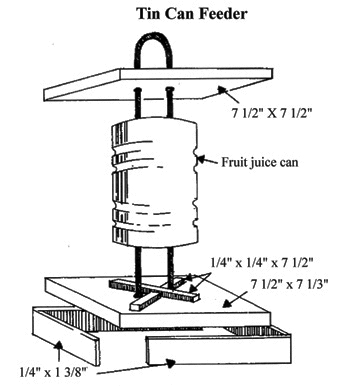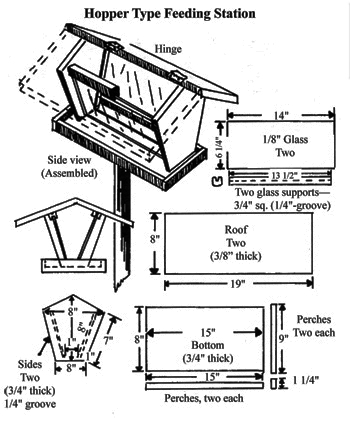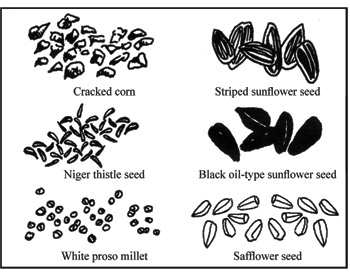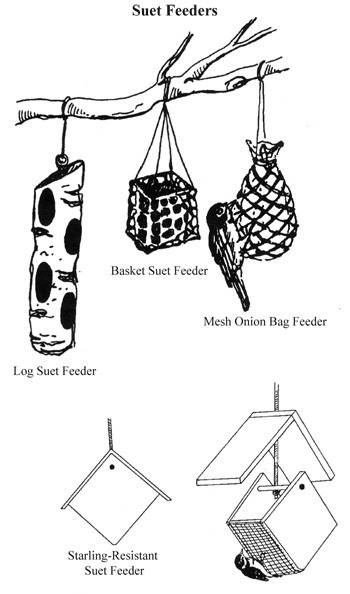G2003
Backyard Wildlife
Feeding Birds
Learn the essentials of bird feeding to attract birds to your backyard.
Ron J. Johnson, Former UNL Extension Wildlife Specialist, current Professor, Clemson University, South Carolina
Mary Bomberger Brown, Coordinator, Tern and Plover Conservation Partnership (TPCP)
Mark S. Kuzila, Project Coordinator for TPCP
|
Bird feeding is a popular and convenient way to observe birds up close, and it augments the primary habitat formed by backyard and neighborhood plantings. Nebraska is an excellent place to discover the joys of learning about birds, with nearly 400 bird species, 200 of which nest in the state. Bird feeding can provide regular observation of 15 to 20 or more species that commonly visit backyard feeders.
To attract birds year-round, provide their three basic needs of food, water, and cover, collectively called habitat. Cover includes shelter from harsh weather and enemies, plus a place for reproduction or nest building. Bird feeders, birdhouses for cavity nesters, a source of water, and various plant materials can help provide habitat needs for backyard birds.
When to Feed
You can start a bird feeding program anytime, but results will vary with the seasons and with which birds are nearby at the time. Some birds are seed-eaters, others eat fruit, some eat insects, and some flower nectar. Some birds prefer feeding on the ground, and others prefer feeding higher up. Some are winter visitors, some are here during summer or migration only, and others are year-round residents.
For winter feeding, it is good to have feeders in place by mid to late September. This will be in time for birds such as chickadees, woodpeckers, and others that are looking for winter feeding areas. And the food will be available to birds that are migrating through. The number of birds that come to your feeder may be low at first but will pick up with the first cold spell, especially if your feeders are in place and ready. Keep in mind that birds probably depend on your feeder most during weather extremes, especially when snow or ice covers natural food sources, and during late winter and early spring when less food is available. During cold weather extremes (example: several days below 0°F), birds such as chickadees have had higher survival rates when supplemental food was available. Ideally, it is best to continue a winter feeding program until about May when new spring growth is underway. If you can’t continue, however, the birds will most likely adapt and be OK. Studies indicate that if feeding is interrupted or discontinued during winter, birds are probably able to switch to other food sources, but be aware that they may be slow to return to your feeders if feeding is resumed.
Feeding birds during summer is becoming more common. Summer feeding may bring fewer birds overall, but summer residents bring variety, and gardening or other outdoor activities often allow close observations of birds at or around the feeder. Nesting and egg-laying activities require considerable energy, so birds that come to your feeder have the extra boost of an easy food source. Most will continue to feed on insects captured in your yard and garden, and will feed insects to their young.
Summer is an opportunity to try some different foods. Grape jelly and orange halves attract orioles. Hummingbirds and orioles like sugar water “nectar” solutions. Fruits such as cut apples (wormy is OK) or raisins soaked in water overnight appeal to a variety of birds such as robins, orioles, catbirds, and cardinals. Mealworms attract bluebirds, cardinals, catbirds, chickadees, native sparrows, and woodpeckers, and often are fed to young in the nest. Pay special attention to food quality in summer to avoid moldy or spoiled foods.
Where to Feed
Try to place feeders so that birds have protection from winds and predators and can avoid window collisions. One study estimated that over 97 million birds collide with windows each year, and collisions can occur when frightened birds fly out from feeders. A good spot to place a feeder is in a somewhat open area but within about 10 feet of cover such as bushes or trees. Some open area allows birds to observe predators, such as cats that might hide, and the shrubs or trees can provide shelter from strong winds and a place to escape from overhead predators. If window collisions occur, move feeders close to the window (within 2-3 feet), or else farther away and at an angle to decrease the appearance of an open flight path. Other options include blocking the reflection by hanging cloth or aluminum foil strips in front of the window, covering it with netting or sheer cloth, or planting shrubs. Hawk or owl silhouettes have limited effectiveness. Types of Feeders Many types of feeders are available commercially, and some basic designs can be made at home. Simple seed feeders can be made from recycled materials such as an empty milk carton or other container (Figure 1). A platform feeder requires only a wooden frame (about 12 x 18 inches) and a bottom with holes for drainage; a screen-wire bottom facilitates drainage and drying and will hold larger seeds. For ease of use, look for feeders that protect the seeds from rain or snow, are easy to fill and clean, and provide a means to dispense feed gradually so spillage is reduced. Some spillage is OK, however, because some birds, such as juncos, prefer to feed on the ground.
Hopper-type seed feeders of various designs are the most common and versatile (Figure 2). These hold a supply of seed that is dispensed gradually as it is used. Specialty feeders include finch feeders that dispense very tiny seeds such as Niger thistle seeds, counterbalanced perch feeders that select for specific bird weights (e.g., cardinals), hummingbird feeders for sugar water mixtures, and suet feeders. For more information on the variety of feeders that you can make or that are available commercially, check the references listed at the end of this article or, for a firsthand look, check with a store that carries a good range of bird feeding products.
|
||||||||||||||||||
A variety of feeders and foods in a variety of spots provides for the greatest diversity of birds and better ensures that less aggressive birds have a place.
Because birds have preferences for where they feed, a variety of feeders attracts more kinds. Small hanging feeders are used by small birds such as chickadees, finches, and nuthatches. Feeders placed low to the ground attract ground-feeding birds such as juncos and native sparrows. Solidly mounted, aboveground feeders will draw in a large variety of birds, including cardinals, chickadees, grosbeaks, finches, various woodpeckers, and many others.
Seeds
When choosing seeds, think about the birds that interest you and the types of seeds that attract them (Table I). Small black oil-type sunflower seeds are overall the most widely preferred bird seed, so these normally are the major portion of seeds offered. They have high energy content, and the thin shells allow easy use by smaller birds such as chickadees, siskins, juncos, and native sparrows, as well as cardinals, doves, grosbeaks, and others. White proso millet is another attractive seed used especially by smaller birds, and a small amount of finely cracked corn is good in a mix. Safflower is being used increasingly, with reports that cardinals, chickadees, finches, nuthatches, and doves consume it, but that it is less attractive to grackles, starlings, House Sparrows, and squirrels. Unsalted peanuts and other nutmeats can make an attractive addition to a feeding program and will appeal to a variety of birds, including woodpeckers, blue jays, cardinals, nuthatches, and chickadees.
Keep in mind that birds prefer good quality seeds that are reasonably fresh (Figure 3). Seeds that are too old or of poor quality may be avoided or just scattered from the feeder onto the ground. Small holes in sunflower seeds, for example, may indicate insect damage and reduced quality. Niger thistle seeds, which are often used in finch feeders, are highly attractive to finches when fresh, but may be rejected when several months old. Although commercially packaged seed mixes offer a convenient way to get started in bird feeding, such mixtures often contain large amounts of filler seeds that birds do not prefer, and the seeds may not be as fresh as ideal. A good alternative is to purchase preferred seeds in bulk and mix your own, or try fresh specialty mixes available from sources that specialize in bird feeding products. One seed combination that is attractive to a wide range of desirable backyard songbirds is:
- 50 percent sunflower seeds
- 35 percent white proso millet
- 15 percent finely cracked corn
|
Many other combinations also work well, and you can adjust mixtures to fit your situation. Food preferences may vary somewhat depending on where you live and on what birds frequent your feeders. Some experienced bird feeders recommend that at least 75 percent of the seed offered should be black oil-type sunflower. You might try experimenting with a few seed types or mixes offered in different spots and see what happens in your backyard.
Grit
Occasionally providing grit, such as sand or fine poultry or canary grit, is also beneficial because it is retained in the gizzard where it helps to grind seeds. When snow covers the ground, birds may resort to using grit from old roofing shingles, which may be unhealthy for them. Eggshells or crushed limestone can serve as grit and may provide a needed calcium source during the egg-laying season. Grit can be mixed with seeds or placed in a tray or on the ground.
Suet
Suet is especially attractive to insect-eaters such as woodpeckers, chickadees, and nuthatches and is a good winter energy source. Commercial no-melt suet preparations can be used throughout the year. Typical suet is the hard, white fat from around the beef kidney area, often available from butcher counters. Other fat sources, including deer fat and rib cages, also can be used. Suet can be fed as it comes from the butcher or melted and mixed with other foods to form suet cakes. Suet is sometimes supplemented with a protein source such as canned dog food, dehydrated eggs, or peanut butter.
Here is one recipe you can use to make your own suet cakes:
- 3 cups melted suet
- 3 cups cornmeal (preferably yellow)
- 1 cup peanut butter (preferably chunk style)
Melt the suet in a pan and add the cornmeal and peanut butter. Bird seeds, raisins, rolled oats, unsalted nutmeats, dehydrated egg, apple bits, brown sugar, honey or syrup also can be added. Add or subtract ingredients depending on what is handy, but avoid ingredients that have rich seasoning. Pour the suet mixture into cupcake papers in a muffin tin to harden. Remove the papers, and the cakes are ready for the birds. The melted suet mixture also can be poured into cut-down cardboard milk cartons or into 1-inch holes drilled into a small log. These can be placed out directly for feeding.
Suet can be fed in a net onion or orange sack or in a suet feeder (Figure 4). Hang suet feeders on or near a tree, on a wooden post, or perhaps from your seed feeder. It is best to keep suet in shade so that it doesn’t melt. Keep it high enough so dogs can’t reach it.
Management Tips
Add a bird bath. Water attracts birds for drinking and bathing and adds an interesting focal point for fascinating scenes of bird behavior.
Good sanitation helps. Keep bird feeders clean and disinfect them occasionally. A solution of one part household bleach to nine parts water is convenient and works well for this. Periodically sweep or rake spilled seeds and seed hulls from under the bird feeder.
To deter squirrels, place feeders at least 7 to 8 feet away from solid tree limbs, fences, or railings, and try to situate feeders so squirrels can’t jump onto them from above. To prevent access from below, erect feeders about 5 feet above the ground so squirrels can’t leap up to them, and add a guard over the feeder pole. Consider foods that squirrels that don’t like — for example, safflower.
Use pesticides wisely and only when truly needed.
Start a backyard bird journal for notes about your backyard and what you see. For example, record the date when migratory birds such as robins, martins, swallows, or bluebirds return to your backyard in spring or depart in fall.
For More Information
Attracting and Feeding Birds
Birds at Your Feeder, A Guide to Feeding Habits, Behavior, Distribution, and Abundance. Dunn, E. H., and D. L. Tessaglia-Hymes. 1999. W.W. Norton. 432 pages.
“For the Birds.” U.S. Fish and Wildlife Service. Web site on attracting backyard birds, including homes for birds, feeding birds, and landscaping for birds. www.pueblo.gsa.gov/cic_text/misc/forbirds/forbird.htm
Natural Resources Conservation Service, Backyard Conservation provides a colorful USDA publication, Backyard Conservation, and a series of tip sheets covering a variety of conservation topics. Available at www.nrcs.usda.gov/Feature/backyard/.
Project FeederWatch. Cornell Laboratory of Ornithology. Information on birds and bird feeding and opportunities to participate in Project FeederWatch programs. Information available at www.birds.cornell.edu/pfw/.
The Backyard Bird Feeder’s Bible: The A-to-Z Guide To Feeders, Seed Mixes, Projects, And Treats. Roth, S. 2000 (paperback 2003). Rodale Press.
The FeederWatcher’s Guide to Bird Feeding. Griggs, J. and M. Barker. 2000. HarperCollins. 136 pages.
Wild About Birds, The DNR Bird Feeding Guide. Henderson, C. L. 1995. Minnesota Department of Natural Resources, Nongame Wildlife Program. 288 pages. Available for purchase from some local bird products stores; the Minnesota Department of Natural Resources gift shop (651) 222-0480; Minnesota’s Bookstore (651) 297-3000; or online at www.dnr.state.mn.us/publications/books/index.html.
Identification and Observation of Birds
The Birder’s Handbook, A Field Guide to the Natural History of North American Birds. Ehrlich, P. R., D. S. Dobkin, and D. Wheye. 1988. New York: Simon & Schuster Inc. 785 pages.
National Geographic Field Guide to the Birds of North America, 5th edition. Dunn, J. L. & J. Alderfer, Editors. 2006. (Washington, DC: The National Geographic Society), 504 pages.
A Field Guide to the Birds of Eastern and Central North America, 5th edition. Peterson, R. T., and V. M. Peterson. 2002. Peterson Field Guides. Houghton Mifflin Company, Boston. 427 pages. (Includes eastern half of Nebraska.)
Birds of North America, A Guide to Field Identification, revised and updated. C. S. Robbins, B. Brunn, and H. S. Zimm, 2001. New York: Golden Press. 360 pages.
The Sibley Field Guide to Birds of Eastern North America. Sibley, D. A. 2003. Alfred A. Knopf, New York. 431 pages. (West to the Rocky Mountains.)
Acknowledgments
Special thanks to M. M. Beck, J. J. Dinan, D. H. Steinegger, and D. K. Titterington for reviewing the draft manuscript and offering helpful suggestions. Thanks also to Reneé Lanik for illustrations.
This publication has been peer reviewed.
Visit the University of Nebraska–Lincoln Extension Publications Web site for more publications.
Index: Wildlife Management
Urban Wildlife
Issued March 2010



